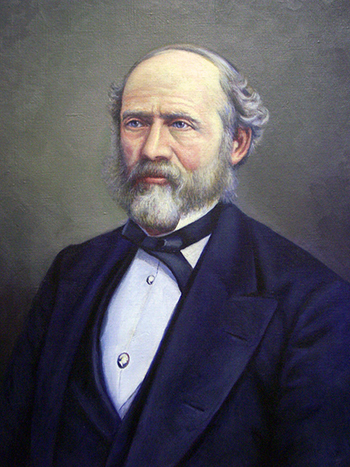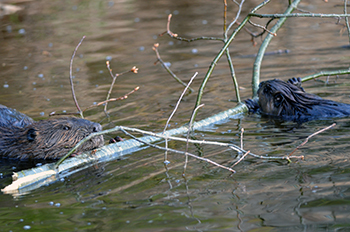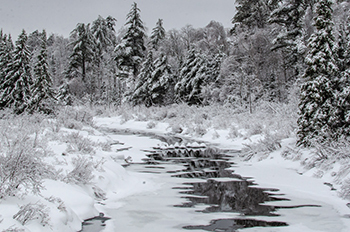|
Morgan’s industrious beavers
By JOHN PEPIN
Michigan Department of Natural Resources
There’s an old trout pond in Marquette County said to have years back held one monster fish, a true pole bender, a devilish delight caught just after sundown on a fluffy makeshift fly cast from a canoe.

In the wetlands surrounding this pool twists a small creek. Near the tall railroad trestle whose decades of passing iron ore cars have left everything below covered with red dust and mud, the creek widens at least once before ducking under the county road through a culvert.
At times, the culvert is clogged with sticks and other materials put there by working beaver intent on blocking the shallow, cold creek from flowing – from singing as it tumbles downstream over the black rocks.
These beavers continue their stick, log and mud works a good deal more than a century after the death of Lewis Henry Morgan, the namesake of the creek, the pond, the land around them and a nearby residential location.
Morgan was to become a famous man, born in New York State in November 1818.
He served as a lawmaker in New York’s State Assembly and State Senate. His fame would arise from his work as an anthropologist and developer of social theory who influenced the likes of Karl Marx and Friedrich Engels.
In expeditions up the Missouri River and to tribal lands in Nebraska and Kansas, Morgan studied more than 50 kinship systems. He would also study extensively the Iroquois people and government treaties.
|

His work sought evidence that all humankind descended from a single source, determined that family and social institutional structures develop following specific patterns and viewed kinship relationships as a foundation of society.
Morgan suggested matrilineal clans, rather than families headed by a patriarch, were the earliest human domestic foundations.
His storied biography is greatly fascinating and commands far more space than the thumbnail sketch allotted here. The same could be said for his numerous writings.
In 1855, Morgan forged his connection to Michigan and the Upper Peninsula when he and other New York investors put money into the region’s metals industry. Morgan was among the men who created the Bay de Noquet and Marquette Railroad Co. He was to become the attorney and director for the railroad line that stretched across the Upper Peninsula.
He worked as a lobbyist defending the interests of the railroad and the sale of lands for iron mining ventures. During this time in Michigan, Morgan became keen on trout fishing, haunting the creeks, rivers and ponds, guided on occasion to hidden fishing waters by Ojibway guides.
|

In pursuit of Michigan’s beautiful brook trout, Morgan became interested in the activities of beavers. He studied them intently for several years before producing his captivating 1868 natural history volume, “The American Beaver and His Works,” a book still available in reprint.
Irene Cheng, in a 2006 piece in Cabinet Magazine, said compared to Charles Darwin’s precise bees, with their mathematically perfect hives, Morgan’s beavers appeared “downright brute-like and their dams primitive.”
“Yet what Morgan admired about the beavers’ works was not the final form so much as the process of reasoning that allowed the animal architect to adapt its constructions intelligently,” Cheng wrote. “Unlike the bees, Morgan’s mutes built not out of base need, or driven by a ‘struggle for existence,’ but to further their own well-being and happiness. He believed that the beaver had a fundamental awareness of its own creation.”
Morgan wrote, “When a beaver stands for a moment and looks upon his work, evidently to see whether it is right, and whether anything else is needed, he shows himself capable of holding his thoughts before his beaver mind; in other words, he is conscious of his own mental processes.”
|

Morgan would return to New York, after a dispute with railroad stakeholders over legal expenses, where he died following his legislative service. He was 63.
A generation later, amid the battle against tuberculosis, the Marquette County’s Morgan Heights Sanatorium was erected in 1911 – Michigan’s first such facility where patients of the bacterial lung disease were observed closely by physicians.
The hospital building, which was razed in 2002, was situated not much more than a stone’s throw from the old trout pond, the winding bubbling brook and the continuing construction of Morgan’s industrious beavers.
|
Check out previous Showcasing the DNR stories in our archive at Michigan.gov/DNRStories. To subscribe to upcoming Showcasing articles, sign up for free email delivery at Michigan.gov/DNR.
Note to editors: This story was issued previously as part of the Outdoors North column series. Contact: John Pepin, Showcasing the DNR series editor, 906-226-1352. Accompanying photos and a text-only version of this story are available below for download. Caption information follows. Credit Michigan Department of Natural Resources, unless otherwise noted.
Text-only Showcasing Story - Morgan-Beavers
Beavers: A group of three beavers works together along the shoreline of a Marquette County lake.
Book: A glimpse into Lewis Henry Morgan's classic book on beavers and their work.
Creek: Morgan Creek in Marquette County is one of several namesake geographic locations near Marquette named for Lewis Henry Morgan.
Morgan: A portrait of Lewis Henry Morgan. (Union College files, public domain)
Stick: Two beavers work to bring a stick to a shoreline area along a Marquette County lake.
|